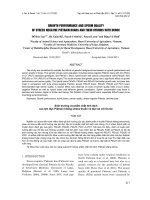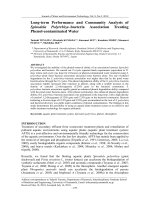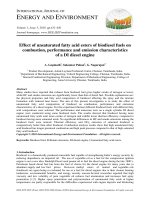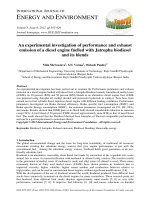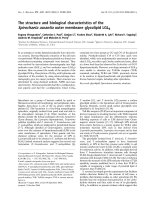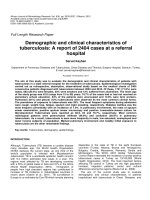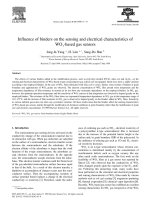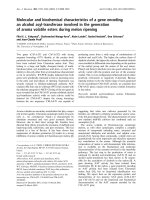Flexural performance and bond characteristics of FRP strengthening techniques for concrete structures
Bạn đang xem bản rút gọn của tài liệu. Xem và tải ngay bản đầy đủ của tài liệu tại đây (22 MB, 327 trang )
FLEXURAL PERFORMANCE AND BOND CHARACTERISTICS OF
FRP STRENGTHENING TECHNIQUES FOR CONCRETE
STRUCTURES
By
Tarek Kamal Hassan Mohamed
A Dissertation
Submitted to the Faculty o f Graduate Studies
In Partial Fulfilment o f the Requirements for the Degree o f
DOCTOR OF PHILOSOPHY
Structural Engineering Division
Department o f Civil and Geological Engineering
The University o f Manitoba
Winnipeg, Manitoba, Canada
© May 2002
Reproduced with permission of the copyright owner. Further reproduction prohibited without permission.
National Library
of Canada
Bibliotheque nationale
du Canada
Acquisitions and
Bibliographic Services
Acquisitions et
services bibliographiques
395 Wellington Street
Ottawa ON K1A0N4
Canada
395, rue Wellington
Ottawa ON K1A0N4
Canada
Your file Votre reference
OurBle Notre reference
The author has granted a non
exclusive licence allowing the
National Library o f Canada to
reproduce, loan, distribute or sell
copies o f this thesis in microform,
paper or electronic formats.
L’auteur a accorde une licence non
exclusive permettant a la
Bibliotheque nationale du Canada de
reproduire, preter, distribuer ou
vendre des copies de cette these sous
la forme de microfiche/film, de
reproduction sur papier ou sur format
electronique.
The author retains ownership of the
copyright in this thesis. Neither the
thesis nor substantial extracts from it
may be printed or otherwise
reproduced without the author’s
permission.
L’auteur conserve la propriete du
droit d’auteur qui protege cette these.
N i la these ni des extraits substantiels
de celle-ci ne doivent etre imprimes
ou autrement reproduits sans son
autorisation.
0-612-79873-9
Canada
Reproduced with permission of the copyright owner. Further reproduction prohibited without permission.
UNIVERSITY OF MANITOBA
FACULTY OF GRADUATE STUDIES
FINAL ORAL EXAMINATION OF T H E PHD THESIS
The undersigned certify that they have read, and recommend to the Faculty o f Graduate Studies for acceptance, a
PhD thesis entitled:
FLEXURAL PERFORMANCE AND BOND CHARACTERISTICS OF FRP STRENGTHENING TECHNIQUES
FOR CONCRETE STRUCTURES
BY
TAREK KAMAL HASSAN MOHAMED
In Partial fulfillment o f the requirements for the PhD Degree
|U 2 s l
Dr. S. H. Rizkalla, Advisor
External Examiner
Dr. Kenneth Neale
Department de Genie Civil, Faculte de Genie
Universite de Sherbrooke
Sherbrooke, Quebec
Dr. A. Mufti
........................................ t i "
Dr. D. Polyzois
Dr. C. Wu
Date o f Oral Examination:.......................................... May 10,2002................................
The Student has satisfactorily completed and passed the PhD Oral Examination.
iSk.
Dr. S. H. Rizkalla, Advisor
Dr. K. Neale
Dr. A. Mufti
Dr. D. Polyzois
!
I
Dr. C. Wu
.........
3 / .................
i d wJL^
Chair o f PhD Oral
(The signature of the Chair does not necessarily signify that the Chair has read the thesis.)
Reproduced with permission of the copyright owner. Further reproduction prohibited without permission.
THE UNIVERSITY OF MANITOBA
FACULTY OF GRADUATE STUDIES
COPYRIGHT PERMISSION
FLEXURAL PERFORMANCE AND BOND CHARACTERISTICS OF FRP STRENGTHENING
TECHNIQUES FOR CONCRETE STRUCTURES
BY
TAREK KAMAL HASSAN MOHAMED
A Thesis/Practicum submitted to the Faculty of Graduate Studies of The University of
Manitoba in partial fulfillment of the requirement of the degree
of
DOCTOR OF PHILOSOPHY
TAREK KAMAL HASSAN MOHAMED © 2002
Permission has been granted to the Library of the University of Manitoba to lend or sell copies of
this thesis/practicum, to the National Library of Canada to microfilm this thesis and to lend or sell
copies of the film, and to University Microfilms Inc. to publish an abstract of this thesis/practicum.
This reproduction or copy of this thesis has been made available by authority of the copyright
owner solely for the purpose of private study and research, and may only be reproduced and copied
as permitted by copyright laws or with express written authorization from the copyright owner.
Reproduced with permission of the copyright owner. Further reproduction prohibited without permission.
Acknowledgments
The author would like to express his deepest gratitude to his supervisor Dr. Sami
Rizkalla. In addition to his support and friendship over the past three years, he has
provided the unwavering source o f inspiration, determination, and leadership that was so
essential for the successful execution o f this research project.
The author would like to thank Dr. Aftab Mufti, Dr. Dimos Polyzois and Dr. Christine
W u for their constructive comments and encouragements throughout the research. The
support provided by the Network o f Centres o f Excellence on the Intelligent Sensing of
Innovative Structures (ISIS Canada) is greatly acknowledged.
The author also expresses his thanks to Mr. M. McVey, Mr. G. W hiteside and Mr. S.
Sparrow for their valuable assistance during the fabrication and testing o f the specimens.
Special thanks are extended to Dr. A. Kamiharako, Dr. A. Sultan, Dr. M. Mohamedien
and Dr. N. Hassan for their assistance during the experimental phase o f this study. The
support provided by Vector Construction Group and Concrete Restoration Services is
greatly appreciated.
Finally, the love, patience and support of my parents, my wife and my daughter cannot be
praised enough; to them this thesis is dedicated.
ii
Reproduced with permission of the copyright owner. Further reproduction prohibited without permission.
Abstract
Strengthening o f reinforced concrete structures using FRPs has emerged as a potential
solution to the problems associated with civil infrastructure. Many researchers have
reported significant increases in strength and stiffness of FRP retrofitted concrete
structures. Nevertheless, possible brittle failures o f the retrofitted system could limit the
use o f the full efficiency o f the FRP system. These brittle failures include premature
debonding of the FRP, which could occur at load levels significantly less than the
strength o f the FRP material used in the retrofitted system. Therefore, there is a need for
an improved understanding o f various failure mechanisms of FRP strengthened concrete
structures as a basis for a reliable retrofit design. Innovative structural detailing is also
needed to utilize the FRP system more effectively.
The work reported in this thesis deals with the development of a comprehensive approach
towards understanding the flexural behaviour o f FRP strengthened concrete structures.
This study presents a comparison among various FRP strengthening techniques and
develops fundamental criteria governing the choice o f a specific technique. The
applicability o f cracked section analysis as well as non-linear finite element simulations
for the analysis o f concrete structures strengthened with FRP reinforcement is
enumerated. Design guidelines regarding the use of FRP in retrofitting applications are
provided. Mathematical models are proposed to quantify the bond characteristics and
load transfer mechanisms of various FRP strengthening schemes using bars and strips for
near surface mounted configurations as well as externally bonded sheets and strips.
iii
Reproduced with permission of the copyright owner. Further reproduction prohibited without permission.
A two-phase experimental program was conducted at the University o f M anitoba to
examine the structural performance o f concrete structures strengthened w ith various FRP
systems. The experimental program was designed to ensure full utilization o f the
strengthening schemes and to avoid possible premature failure o f the retrofitted system.
Three half-scale models o f a typical concrete bridge slab were constructed and tested in
the first phase o f the investigation. The performance o f near surface m ounted FRP bars
and strips as well as externally bonded FRP sheets and strips was evaluated. The three
specimens were used to perform a total o f nine tests in this phase. A cost analysis for
each of the FRP strengthening techniques considered in this investigation was performed.
Complementary to the experimental program, numerical simulations were performed
using finite element analysis to predict the behaviour o f concrete members strengthened
with near surface mounted FRP reinforcement. Based on test results, the investigation
was extended to a second stage to provide fundamental data for the bond characteristics
o f efficient FRP techniques. A total of 24 concrete T-beams were tested to characterize
the load transfer mechanisms between FRP and concrete. Three different strengthening
techniques were investigated. For each technique, different bond lengths were
considered. Based on the experimental results, development lengths for various FRP
strengthening techniques are proposed.
The thesis also presents three analytical models, proposed to predict the behaviour of
concrete structures strengthened with near surface mounted FRP bars, near surface
mounted FRP strips and externally bonded FRP sheets. New methodologies are
introduced as a basis for design. With the formulae proposed in this thesis, the risk o f
iv
Reproduced with permission of the copyright owner. Further reproduction prohibited without permission.
premature failure o f concrete structures strengthened with various FRP systems can be
estimated. The entire investigation leads to simple design rules, with a profound
theoretical basis, to allow an economical, safe and reliable FRP retrofit design for
concrete structures and bridges.
V
Reproduced with permission of the copyright owner. Further reproduction prohibited without permission.
Table of Contents
Acknowledgments..........................................................................................................................ii
A bstract.................................................
iii
Table o f Contents................................. ....:,................................................................................. vi
Notation......................................................
xiv
Chapter 1. Introduction
1.1 G eneral.......................................................................................................................................1
1.2 Research O bjective................................................................................................................. 3
1.3 Research A pproach................................................................................................................. 5
1.4 Outline o f the Thesis............................................................................................................... 8
Chapter 2. Strengthening of Reinforced Concrete Structures with FRPs
2.1 Introduction.............................................................................................................................10
2.2 Strengthening o f Concrete Structures
.......................................................................... 11
2.2.1 Historical Background.................................................................................................. 11
2.2.2 Concrete Beams Strengthened with Steel P lates...................................................... 14
2.2.3 Concrete Beams Strengthened with F R P s................................................................. 20
2.3 Concrete — Steel/FRP Interface Bond Strength..............................................................24
2.3.1 Effect o f Surface Preparation on Bond Performance................................................28
2.3.2 Effect o f Adhesive on Bond Perform ance................................................................. 28
2.3.3 Effect o f FRP Stiffness on Bond Perform ance..........................................................29
2.3.4 Effect of Concrete Strength on Bond Perform ance..................................................29
2.4 Failure Mechanisms o f Concrete Beams Strengthened with F R P s............................... 30
2.4.1 G eneral.......................................................................................................................... 30
vi
Reproduced with permission of the copyright owner. Further reproduction prohibited without permission.
2.4.2 Flexural Failures............................................................................................................ 31
2.4.3 Shear Failures................................................................................................................. 35
2.4.4 Debonding Failures........................................................................................................36
2.4.4.1 Delamination M odels
.................................................................................42
2.4.4.2 Applicability o f Delamination M o d els............................................................... 59
2.5 Existing Design Procedures for Delamination...................................................................60
2.5.1 General............................................................................................................................ 60
2.5.2 Professional O rganizations...........................................................................................60
2.5.2.1 American Concrete Institute................................................................................. 60
2.5.2.2 The Canadian Network o f Centres o f Excellence..............................................61
2.5.23 German Institute for Construction Technology................................................. 62
2.5.2.4 Japan Concrete Institute and Jpan Society o f Civil E ngineers........................63
2.5.2.5 International Conference of Building O fficials................................................. 63
2.5.3 Retrofit System M anufacturers.................................................................................... 63
2.5.3.1 S ik a ................................................................................................
63
2.5.3.2 MBrace Composite Strengthening Systems........................................................64
2.5.3.3 S&P Composite Reinforcing System s................................................................ 64
2.5.4 Independent Researchers..............................................................................................65
2.6 Bond Characteristics o f FRP R ebars..................................................................................65
2.6.1 G eneral............................................................................................................................ 65
2.6.2 Bond M echanism .....................................
66
2.6.3 Factors Affecting Bond Perform ance......................................................................... 67
2.6.4 Bond-Slip M odels..........................................................................................................67
vii
Reproduced with permission of the copyright owner. Further reproduction prohibited without permission.
2.7 Strengthening o f Reinforced Concrete Structures Using N ear Surface............................
Mounted FRP Reinforcem ent.................................................................................................... 69
2.8 Field A pplications................................................................................................................. 75
2.9 Durability o f FRP Strengthening Techniques................................................................... 79
2.9.1 G eneral............................................................................................................................ 79
2.9.2 Wet— Dry Exposure...................................................................................................... 80
2.9.3 Freeze— Thaw Exposure.......................................................
81
2.9.4 Thermal Exposure..........................................................................................................82
2.9.5 Fatigue......................................................................
83
Chapter 3. Experimental Program
3.1 General.................................................................................................................................... 85
3.2 Phase I o f the Experimental Program ...............................................................................87
3.2.1 Large-Scale Slab Specimens........................................................................................ 87
3.2.2 Fabrication o f the Specimens....................................................................................... 91
3.2.2.1 Preparation o f the Forms.............................................................
91
3.2.2.2 Stressing o f the Tendons....................................................................................... 92
3.2.2.3 G routing.................................................................................................................. 94
3.2.3 Strengthening Techniques.............................................................................................95
3.2.4 Instrum entation...................
105
3.2.4.1 Cantilever T e sts................................................................................................... 105
3.2.4.2 Simply Supported T ests...................................................................................... 109
3.2.5 Testing Schem e............................................................................................................ I l l
3.2.5.1 Cantilever T e sts ................................................................................................... 111
3.2.5.2 Simply Supported T ests...................................................................................... 113
viii
Reproduced with permission of the copyright owner. Further reproduction prohibited without permission.
3.3 Phase II o f the Experimental Program ............................................................................. 115
3.3.1 Bond Specimens......................................................................
115
3.3.2 Fabrication of the Specimens..................................................................................... 119
3.3.3 Strengthening Procedures
.............................................................................. 119
3.3.4 Instrumentation.............................
123
3.3.5 Testing Scheme................................................................................................
124
3.4 Materials
.......................................................
124
3.4.1 C oncrete........................................................................................................................124
3.4.2 Prestressing S teel.........................................................................................................125
3.4.3 Sheathing.......................................................................................................................127
3.4.4 Mild Steel......................................................................................................................127
3.4.5 Leadline......................................................................................................................... 127
3.4.6 S&P CFRP Strips........................................................................................................ 128
3.4.7 MBrace CFRP S heets................................................................................................. 130
3.4.8 C -B A R ................................................................................................:.........................130
Chapter 4. Experimental Results & Analytical Modelling: Large-Scale Slab
Specimens
4.1 Introduction.......................................................................................................................... 131
4.2 Experimental R esults..........................................................................................................133
4.2.1 G eneral.....................................
133
4.2.2 Cantilever Test R esults............................................................................................... 135
4.2.2.1 Deflection.............................................................................................................. 135
4.2.2.2 Failure M odes...................................................................................................... 138
4.2.2.3 Tensile Strains...................................................................................................... 141
Reproduced with permission of the copyright owner. Further reproduction prohibited without permission.
4.2.2A Crack Patterns....................................................................................................... 144
4.2.2.5 Crack W idth......................
147
4.2.3 Cost A nalysis................................................................................................................150
4.2.4 Test Results of the Simply Supported Specim ens.................................................. 153
4.2.4.1 General...................................................................................................................153
4.2.4.2 Deflection............................................
154
4.2.4.3 Failure M odes....................................................................................................... 155
4.2.4.4 Tensile Strains....................................................................................................... 157
4.2.4.5 Crack Patterns....................................................................................................... 162
4.2.5 Deformability................................................................................................................166
4.3 Analytical M odelling........................................................................................................ 168
4.3.1 Introduction...................................................................................................................168
4.3.2 Cracked-Section Analysis........................................................................................... 169
4.3.3 Finite Element Sim ulation.......................................................................................... 173
4.3.3.1 Background..................................................................................
173
4.3.3.2 Development of the Finite Element M odel...................................................... 174
4.3.3.3 Modelling of the Cantilever S la b s.....................................................................178
4.3.3.4 Modelling o f the Simply Supported Slabs........................................................183
4.3.3.5 Material M odelling.............................................................................................. 184
4.3.4 Results and D iscussion................................................................................................185
4.3.4.1 Cantilever Specimens.................................
185
4.3.4.2 Simply Supported Specim ens.............................................................................191
x
Reproduced with permission of the copyright owner. Further reproduction prohibited without permission.
Chapter 5. Experimental Results & Analytical Modelling: Bond Specimens
5.1 Introduction.......................................................................................................................... 194
5.2 Near Surface Mounted FRP B ars...................................................................................... 197
5.2.1 Experimental Results (Series A )................................................................................197
5.2.2 Analytical M odelling..................................................................................................207
5.2.2.1 Significance o f the M odel...................................................................................207
5.2.2.2 ACI Approach for Steel B ars............................................................................. 207
5.2.2.3 Proposed Approach for NSM FRP bars........................................................... 209
5.2.2.4 Coefficient o f Friction (//).................................................................................. 216
5.2.2.5 Comparison with Experimental Results........................................................... 217
5.2.2.6 Comparison with ACI— 440.............................................................................. 218
5.2.2.7 Detailing G uidelines........................................................................................... 220
5.2.2.8 Maximum Stresses in NSM Bars
(J f r p )
............................................................225
5.3 Near Surface Mounted CFRP Strips................................................................................ 231
5.3.1 Experimental Results (Series B )............................................................................... 231
5.3.2 Analytical M odelling..................................................................................................235
5.3.2.1 General
............................................................................................................235
5.3.2.2 Derivation o f the M odel...............
235
5.3.2.2.1 Simply Supported Beam Subjected to a
Concentrated L o ad ........... 235
5.3.2.2.2 Simply Supported Beam Subjected to a
Uniform Load.................... 240
5.3.2.2.3 Simply Supported Beam Subjected to Two Concentrated Loads
241
5.3.2.3 Failure Criterion...................................................................................................241
5.3.2.4 Verification o f the Analytical M odel................................................................243
xi
Reproduced with permission of the copyright owner. Further reproduction prohibited without permission.
5.3.2.4.1 Modelling o f Test Specim ens.....................................................................243
5.3.2.4.2 Comparison with Finite Element A nalysis...............................................247
5.3.2.4.3 Comparison with Experimental Results.................................................... 249
5.3.2.5 Parametric Study................
251
5.4 Externally Bonded CFRP Sheets....................................................................................256
5.4.1 Experimental Results (Series C )....................................................................
256
5.4.2 Analytical M odelling..................................................................................................260
5.4.2.1 Background...........................................................................................................260
5.4.2.2 Proposed Approach for Externally Bonded FRP Reinforcem ent.................261
5.4.2.3 Failure Criterion...................................................................................................263
5.4.2.4 Comparison with Experimental Results............................................................265
5.4.2.5 Parametric Study..................................................................................................268
Chapter 6. Summary & Conclusions
6.1 G eneral...............................................................................
272
6.2 Sum m ary.............................................................................................................................. 273
6.2.1 Experimental Investigation........................................................................................ 273
6.2.2 Analytical Phase...........................................................................................................274
6.3 Conclusions..........................................................................................................................275
6.3.1 Effectiveness o f FRP System s...................................................................................275
6.3.2 Bond Characteristics o f FRP Strengthening System s............................................ 278
6.3.2.1 General Conclusions........................................................................................... 278
6.3.2.2 Near Surface Mounted CFRP B ars....................................................................279
6.3.2.3 Near Surface Mounted CFRP Strips................................................................. 281
6.3.2.4 Externally Bonded CFRP Sheets.......................................................................282
xii
Reproduced with permission of the copyright owner. Further reproduction prohibited without permission.
6.4 Recommendations for Future Research......................................................................... 283
References .............................................................................................................................. 284
xiii
Reproduced with permission of the copyright owner. Further reproduction prohibited without permission.
Notation
tf/,2,3
=
Coefficients used to determine the applied moment on a concrete beam
A
=
Cross-sectional area o f a concrete section
Ac
=
Area o f concrete in compression
Ap
=
Area o f prestressed steel reinforcement
A/
=
Area o f CFRP reinforcement
As
=
Area o f tension steel reinforcement
A S’
=
Area o f compression steel reinforcement
b
=
Width o f concrete section
b 1,2,3
—
Coefficients defined by Equation 2.7.
bf
=
Width o f externally bonded FRP sheets/strips
bs
-
Width o f externally bonded steel plates
c
=
Depth o f the neutral axis from the extreme compression fibres
ccr
=
Neutral axis depth for the cracked transformed section;
ceff
=
Effective neutral axis depth for the transformed section;
cg
=
Neutral axis depth for the gross transformed section;
Ci, C2 -
Parameters in the solution o f differential equation;
C
=
Clear cover o f reinforcing bars
Cs’
=
Compression force in steel reinforcement
d
-
Depth from extreme compression fibre to the flexural reinforcement;
diameter o f near surface mounted FRP bar
df
=
Depth o f near surface mounted CFRP strips from compression fibre
dp
=
Depth o f the prestressing steel from compression fibre
xiv
Reproduced with permission of the copyright owner. Further reproduction prohibited without permission.
Depth of the internal steel reinforcement from compression fibre
D
Deformability index
e
=
E
Eccentricity o f tendons; edge distance
Efficiency o f FRP strengthening techniques
Ea
=
Modulus o f elasticity o f the adhesive
Ec
=
Modulus o f elasticity o f concrete
Ef
=
Modulus o f elasticity o f FRP reinforcement
EP
=
Modulus o f elasticity o f the steel strands
Es
Modulus o f elasticity o f steel reinforcement
j Bottom ~~
Concrete stress at bottom fibres
fc
Concrete stress in compression
f t
=
Splitting tensile strength o f concrete
fc
=
Compressive strength o f concrete after 28 days
I
-
Maximum tensile stress in near surface mounted FRP bars
fp s
=
Stress in steel strands
ff
=
frp
Stress in CFRP reinforcement
fp u
Ultimate stress in steel strands
fs
Stress in tension steel reinforcement
fs
'
=
Stress in compression steel reinforcement
Tensile stress in concrete after cracking
t
II
ft
fy
G 1,2,2'
Concrete stress at top fibres
=
Yield stress o f steel reinforcement
=
Coefficients for near surface mounted FRP bars
Reproduced with permission of the copyright owner. Further reproduction prohibited without permission.
Ga
=
Shear modulus of the adhesive
Gf
=
Fracture energy
h
=
Total height o f a concrete section
h r (transformed)
~ Cracked moment o f inertia o f the transformed strengthened section
Ieff
=
Effective moment o f inertia o f the transformed strengthened section
If
=
Moment o f inertia o f the FRP sheets
I g (transform ed) =
Gross moment o f inertia o f the transformed strengthened section
kn
=
Parameter defined by Equation 5.48
L
=
Embedment/bond length o f FRP reinforcement, length o f tendons
L'
=
Total span o f the simply supported beam
Ld
—
Development length o f reinforcement
Le
=
Effective bond length
Lg
=
Gauge length
l0
=
Unbonded length o f the CFRP reinforcement
Ma
=
Applied moment on a concrete section
Mcr
=
Cracking moment o f a concrete section
Muve
-
Moment due to specified live load
Mp
=
Applied moment at peeling failure
Mu
=
Ultimate moment capacity o f a concrete section
Ms
-
Moment corresponding to a concrete compressive strain o f 0.001
Msw
=
Moment due to self weight
N
=
Normal force acting on the FRP at the two ends o f a segment
n
=
Number o f cracks passing through a PI gauge; modular ratio; number o f
xvi
Reproduced with permission of the copyright owner. Further reproduction prohibited without permission.
FRP layers
p
=
Applied load
Per
-
Cracking load
Pd
=
Debonding/delamination load
Pe
=
Effective prestressing force after loses
Po
=
Required prestressing force in the tendons
Pj
=
Jacking force
P«
=
Failure load o f the specimen
q
=
Applied uniform load
S
:
Clear spacing between grooves
S
=
Section modulus o f the concrete
ta
=
Thickness o f the adhesive layer
tc
=
Thickness o f concrete in shear-type specimens
=
Thickness o f CFRP strip/sheet
=
Tensile force in CFRP reinforcement
=
Tensile force in prestressing reinforcement
Ts
=
Tensile force in steel reinforcement
u
=
Longitudinal displacement in the adhesive layer
Ue
=
Elastic energy o f the system
V
=
Vertical displacement in the adhesive layer
Vc
=
Shear force in the concrete at cutoff points due to interfacial shear stresses
=
Shear force in the FRP sheets at cutoff points due to interfacial shear
tf
Tf
TP
Vf
stresses
xvii
Reproduced with permission of the copyright owner. Further reproduction prohibited without permission.
V0
=
Shear force in the concrete beam at cutoff points due to externally applied
loads
Vp
-
Peeling shear force
Vu
=
Ultimate shear capacity o f a beam
w
=
Groove width; transverse displacement in the adhesive layer
W
=
Work done by external force
wavg
=
Average crack width
x
=
Longitudinal coordinate starting from the cut-off point o f the CFRP
strip/sheet
y
=
Distance from the FRP laminate to the section neutral
axis
y eff
-
Effective distance from the CFRP strip/sheet to the neutral axis
a
=
Curve fitting parameter less than 1.0
«/
=
An empirical constant, depends on the concrete compressive strength;
factor accounts for the bond characteristics o f reinforcement
=
P
=
Factor accounts for the type o f loading
Angle of inclination o f the resultant o f bond forces to the bar axis,
parameter defined by Equation 5.49
Pi
=
An empirical constant, depends on the concrete compressive strength
8
=
Slip of the FRP reinforcement
8/
=
Maximum slip
Si
=
Slip at maximum bond stress
A
=
Tendon elongation
Acr
=
Deflection at cracking
xviii
Reproduced with permission of the copyright owner. Further reproduction prohibited without permission.
Af,
=
Horizontal displacement measured by the PI gauge
4s
=
Deflection corresponding to a concrete compressive strain o f 0.001
Au
=
Deflection at failure
£c
=
Concrete strain at the extreme compression fibre; interfacial strain o f
concrete
s ce
=
Concrete strain at the level o f the prestressing steel due to prestressing
Scr
-
Maximum tensile strain in the concrete at cracking
ect
—
Average tensile strain in concrete after cracking
se
=
Effective strain in the prestressing steel after losses
Sf
=
Interfacial strain o f CFRP strips
£ju
=
Rupture tensile strain o f the FRP reinforcement
s0
=
Initial strain in the concrete at the time o f strengthening
£ps
=
Strain in the steel strands
£u
=
Maximum tensile strain o f the FRP reinforcement at failure
(f>
=
Curvature at a given strain increment
y
=
Shear strain in the adhesive
Km
=
Reduction factor for the tensile strain in externally bonded FRP
reinforcement
//
=
Coefficient of friction between near surface mounted FRP bars and epoxy
Pf
=
Reinforcement ratio o f FRP
ps
=
Reinforcement ratio o f steel
=
Normal stress in the concrete
xix
Reproduced with permission of the copyright owner. Further reproduction prohibited without permission.
O'con-epoxy
Tensile stress at the concrete-epoxy interface
Of
Normal stress in the CFRP strip
GFRP-epoxy ~
Tensile stress at the FRP-epoxy interface
Normal stress at sheets cutoff points
Cnmax
Normal strength at sheets cutoff points
Gradial
Radial stresses around a near surface mounted FRP bar
T
=
Interfacial shear stress; average bond stress
?
Peak bond stress
Tmax
shear strength
CO, co '
-
Parameters defined by Equations 5.22 and 5.47, respectively
XX
Reproduced with permission of the copyright owner. Further reproduction prohibited without permission.
Chapter 1
Introduction
This chapter gives an introduction to the main topic o f this doctoral thesis and highlights the needs fo r
strengthening using innovative FRP techniques. Background information and lack o f knowledge
concerning various strengthening techniques are discussed. Research objectives as well as the research
approach are enumerated. Finally, the aims and the outline o f this doctoral thesis are clarified.
1.1 General
The need for repair and strengthening o f deteriorated, damaged and substandard civil
infrastructure has become an important challenge confronting the repair and rehabilitation
industries worldwide. Deterioration o f structures begins shortly after completion of
construction due to environmental influences and/or due to the structures’ routine use.
Deficiency o f structures may be the result o f insufficient reinforcement, excessive
deflections, poor concrete quality, reinforcement corrosion, or insufficient bearing
capacity. In some cases, strengthening and repairing are necessary to account for human
mistakes at the designing stage or to solve execution errors during the construction. For
these purposes, various strengthening techniques have been developed to satisfy the
demand to increase the load carrying capacity and/or to fulfill certain serviceability
Reproduced with permission of the copyright owner. Further reproduction prohibited without permission.
_________________________________________________________________________________1 . Introduction
requirements. Some o f the traditional strengthening techniques for concrete structures
are:
■ introducing extra supports to shorten the span o f flexural members;
■ adding reinforcement by subsequently removing and casting concrete;
■ applying additional internal or external prestressing;
■ bonding external steel plates; and
■ using advanced composite materials.
Continuous development of Fiber Reinforced Polymer (FRP) materials in various forms
and configurations offers an alternative design approach for the construction o f new
structures and rehabilitation o f existing civil engineering infrastructure. Nevertheless,
their applications to bridges and structures are still relatively few. FRPs offer designers
an excellent combination o f properties not available for other materials and present a
potential solution to civil infrastructure’s crisis. High strength-to-weight ratio, ease o f
installation and corrosion resistance characteristics make FRPs ideal for strengthening
applications. Externally bonded FRP sheets and strips are currently the most commonly
used techniques for strengthening bridges and concrete structures. In spite o f the
significant research being reported on their structural mechanism and performance, there
are still heightened concerns regarding possible premature failure due to debonding,
especially in zones o f combined high flexural and shear stresses. In addition, externally
bonded FRP reinforcements are relatively unprotected against wear and impact loads.
Thus, their structural performance could be greatly affected by harsh environmental
conditions.
2
Reproduced with permission of the copyright owner. Further reproduction prohibited without permission.
